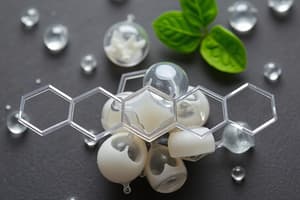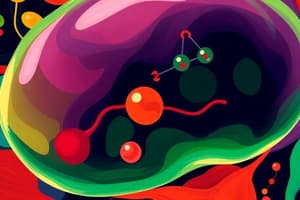Podcast
Questions and Answers
What are the three types of fatty acids?
What are the three types of fatty acids?
Saturated fatty acids, polyunsaturated fatty acids, monounsaturated fatty acids.
What are the AMDR for fats?
What are the AMDR for fats?
20-35% of kcals.
How many carbons are in long chain fatty acids? Medium? Short?
How many carbons are in long chain fatty acids? Medium? Short?
LCFA: 16-18 Carbons, MCFA: 12-14 Carbons, SCFA: 4-8 Carbons.
Give an example of shorthand to write fatty acids.
Give an example of shorthand to write fatty acids.
What are the 2 essential fatty acids? What type of fatty acids are they?
What are the 2 essential fatty acids? What type of fatty acids are they?
What are trans fats? Why were they created?
What are trans fats? Why were they created?
Define Hydrogenation.
Define Hydrogenation.
What is the role of cholesterol in the body? What vitamin does cholesterol make?
What is the role of cholesterol in the body? What vitamin does cholesterol make?
What are phospholipids? What is their solubility?
What are phospholipids? What is their solubility?
What fats/oils are classified as saturated?
What fats/oils are classified as saturated?
What fats/oils are classified as monounsaturated?
What fats/oils are classified as monounsaturated?
What fats/oils are classified as polyunsaturated?
What fats/oils are classified as polyunsaturated?
What is the role of bile in fat digestion? What is emulsification of fats?
What is the role of bile in fat digestion? What is emulsification of fats?
What is the role of CCK in fat digestion?
What is the role of CCK in fat digestion?
What are the different lipoproteins and the role of each?
What are the different lipoproteins and the role of each?
What are the 4 components of the lipoproteins?
What are the 4 components of the lipoproteins?
Which lipoprotein is the largest? Why? What is it mostly made of?
Which lipoprotein is the largest? Why? What is it mostly made of?
What are the health benefits of Omega 3 fatty acids?
What are the health benefits of Omega 3 fatty acids?
What increases your blood cholesterol more, saturated fat or dietary cholesterol?
What increases your blood cholesterol more, saturated fat or dietary cholesterol?
What are the desired blood levels for cholesterol?
What are the desired blood levels for cholesterol?
Study Notes
Fatty Acids
- Types include saturated, monounsaturated, and polyunsaturated fatty acids.
- Long-chain fatty acids (LCFA) contain 16-18 carbons, medium-chain fatty acids (MCFA) have 12-14 carbons, and short-chain fatty acids (SCFA) consist of 4-8 carbons.
Dietary Recommendations
- Acceptable macronutrient distribution range (AMDR) for fats is 20-35% of total caloric intake.
Essential Fatty Acids
- Omega-3 (linolenic) and Omega-6 (linoleic) are essential fats that must be obtained through diet.
Trans Fats
- Trans fats mimic saturated fats and are created during hydrogenation, which alters double bonds from cis to trans configurations.
Hydrogenation
- Process that protects oils against oxidation and converts liquid oils into solid fats at room temperature.
Cholesterol
- Vital for producing bile acids, sex hormones, adrenal hormones, and vitamin D; also serves as a structural component of cell membranes.
Phospholipids
- Contain a fatty acid portion that is lipid-soluble and a phosphate group that is water-soluble; act as emulsifiers in food (e.g., lecithin).
Saturated Fats
- Common sources include tropical oils (coconut and palm oil), butter, and beef fat.
Monounsaturated Fats
- Found in olive and canola oils.
Polyunsaturated Fats
- Present in oils such as corn, cottonseed, walnut, sunflower, soybean, and safflower.
Digestion and Emulsification
- Bile acids function as emulsifiers, helping to mix fats with water, enhancing fat digestion. Bile is recycled or excreted, affecting body cholesterol levels.
Role of CCK
- The hormone cholecystokinin (CCK) is released in response to fatty foods in the small intestine, stimulating bile release from the gallbladder.
Lipoproteins
- LDL (low-density lipoprotein) transports triglycerides and cholesterol to body cells, known as "bad cholesterol."
- VLDL (very-low-density lipoproteins) distributes liver-made cholesterol and fatty acids and eventually becomes LDL as it shrinks.
- HDL (high-density lipoprotein) is regarded as "good cholesterol," carrying cholesterol back to the liver for recycling.
- Chylomicron is the largest lipoprotein, transporting diet-derived lipids from the small intestine through the lymphatic system.
Health Benefits of Omega-3 Fatty Acids
- Associated with lower rates of heart disease, enhanced brain development, cognition, mood regulation, and reduced LDL levels.
Impact on Blood Cholesterol
- Saturated fats significantly raise blood cholesterol levels compared to dietary cholesterol, which has a lesser effect.
Desired Cholesterol Levels
- Target blood cholesterol level is 100 mg/dL, with blood pressure recommended to be below 130/85. For abnormal obesity, waist circumference thresholds are >40 inches for men and >35 inches for women.
Studying That Suits You
Use AI to generate personalized quizzes and flashcards to suit your learning preferences.
Description
Test your knowledge of lipids with these flashcards covering essential concepts such as fatty acid types and dietary recommendations. This quiz includes definitions and examples that are crucial for understanding fats and their role in nutrition.




